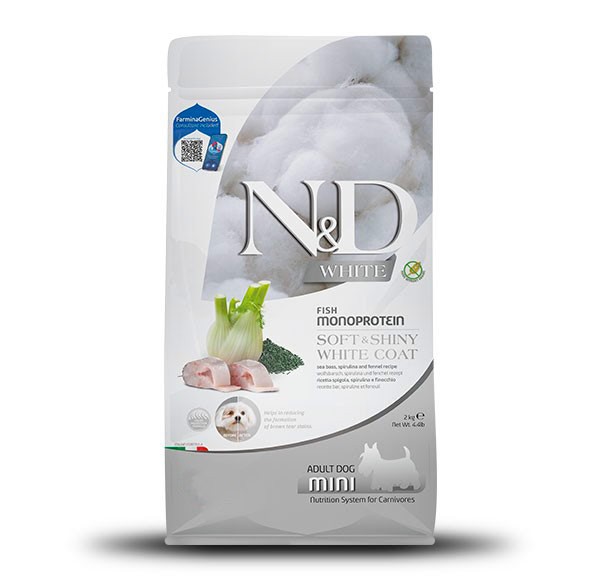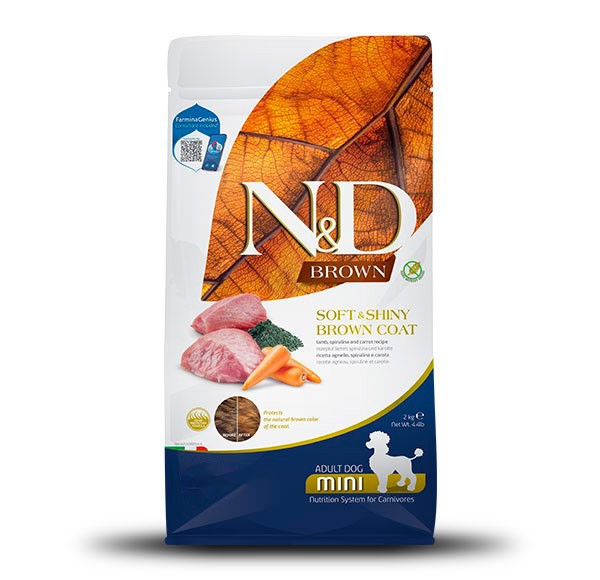N&D White i N&D Brown
ISHRANOM DO MEKOG I SJAJNOG KRZNA
Mekana i sjajna dlaka je znak zdravlja kod pasa. Zato smo stvorili Farmina N&D White i N&D Brown liniju hrane saColor Protection Formulom za očuvanje boje krzna, kako bismo smanjili rizik da boja krzna bledi i rizik od stvaranja mrlja.
N&D White je za bele pse i pomaže da njihovo krzno ostane sjajno i bez mrlja. N&D Brown je za smeđe pse i pojačava intenzitet boje krzna i sjaja dlake
Pažljivo birane sirovine u našim proizvodima obezbeđuju sve potrebne hranljive materije. Uz pravilnu ishranu, Vaš ljubimac će izgledati zdravije, i osećaće se bolje

N&D White
Hrana posebno formulisana da prirodnim uspostavljanjem balansa smanji rizik od stvaranja mrlja na belom krznu. Hrana sadrži jedan izvor proteina životinjskog porekla visoke biološke vresnosti, sa niskim nivoom fenilalanina, tirozina i bakra i Omega-3 masnih kiselina.
Proizvod je idealan za rase kao što su pudle, malteški psi, zapadnjački beli terijeri i druge pse malih rasa sa belom dlakom.
N&D BROWN
Nova linija N&D Brown naučno je formulisana tako da prirodno pojača intenzitet boje krzna i sjaj dlake, kao i da smanji mogućnost da boja vremenom bledi. Sadrži proteine visoke biološke vrednosti, visok nivo fenilalanina i torizina, adekvatan sadržaj bakra i omega-3 mashih kiselina.
Idealan je za sve braon rase kao što su čivava, šnaucer, francuski buldog, pinč i pudla, kao i za sve ostale pse malih rasa sa braon dlakom.

Ne zaboravite da preuzmete aplikaciju
Pitajte svog Genius savetnika da li ovaj proizvod savršeno odgovara Vašem ljubimcu. Preuzmite FarminaGenius aplikaciju ili uključite svog ljubimca u Pet Care Program na našoj internet stranici!
Kontaktirajte Famina savetnika za ishranu
Istražite N&D White i N&d Brown
Obezbedite svojim krznenim prijateljima ishranu koja im je potrebna za blistavo i sjajno krzno.


LITERATURA
Naučne studije koje podržavaju našu hranu za očuvanje boje krzna
1. Ortonne, J. P., & Prota, G. (1993). Hair melanins and hair color: Ultrastructural and biochemical aspects. The Journal of Investigative Dermatology, 101(1 Suppl), 82S-89S. https://doi.org/10.1111/1523-1747.ep12362884
2. Busch-Kschiewan, K., Zentek, J., Wortmann, F. J., & Biourge, V. (2004). UV light, temperature, and humidity effects on white hair color in dogs. Journal of Nutrition, 134(8 Suppl), 2053S-2055S. https://doi.org/10.1093/jn/134.8.2053S
3. Watson, A., Wayman, J., Kelley, R., Feugier, A., & Biourge, V. (2018). Increased dietary intake of tyrosine upregulates melanin deposition in the hair of adult black-coated dogs. Animal Nutrition, 4(4), 422-428.
https://doi.org/10.1016/j.aninu.2018.02.001
4. Anderson, P. J., Rogers, Q. R., & Morris, J. G. (2002). Cats require more dietary phenylalanine or tyrosine for melanin deposition in hair than for maximal growth. Journal of Nutrition, 132(7), 2037-2042.
https://doi.org/10.1093/jn/132.7.2037
5. Yu, S., Rogers, Q. R., & Morris, J. G. (2001). Effect of low levels of dietary tyrosine on the hair colour of cats. Journal of Small Animal Practice, 42(4), 176-180. https://doi.org/10.1111/j.1748-5827.2001.tb01798.x
6. Slominski, A. (1989). L-tyrosine induces synthesis of melanogenesis related proteins. Life Sciences, 45(19), 1799-1803. https://doi.org/10.1016/0024-3205(89)90520-1
7. Watson, A., Servet, E., Hervera, M., & Biourge, V.(2015). Tyrosine supplementation and hair coat pigmentation in puppies with black coats – A pilot study. Journal of Applied Animal Nutrition, 3. https://doi.org/10.1017/jan.2015.8
8. Morris, J. G., Yu, S., & Rogers, Q. R. (2002). Red hair in black cats is reversed by addition of tyrosine to the diet. Journal of Nutrition, 132(6 Suppl 2), 1646S-1648S. https://doi.org/10.1093/jn/132.6.1646S
9. Watson, A., et al. (2017). Nutritional components can influence hair coat colouration in white dogs. Journal of Applied Animal Nutrition, 5, e5. https://doi.org/10.1017/jan.2016.3


